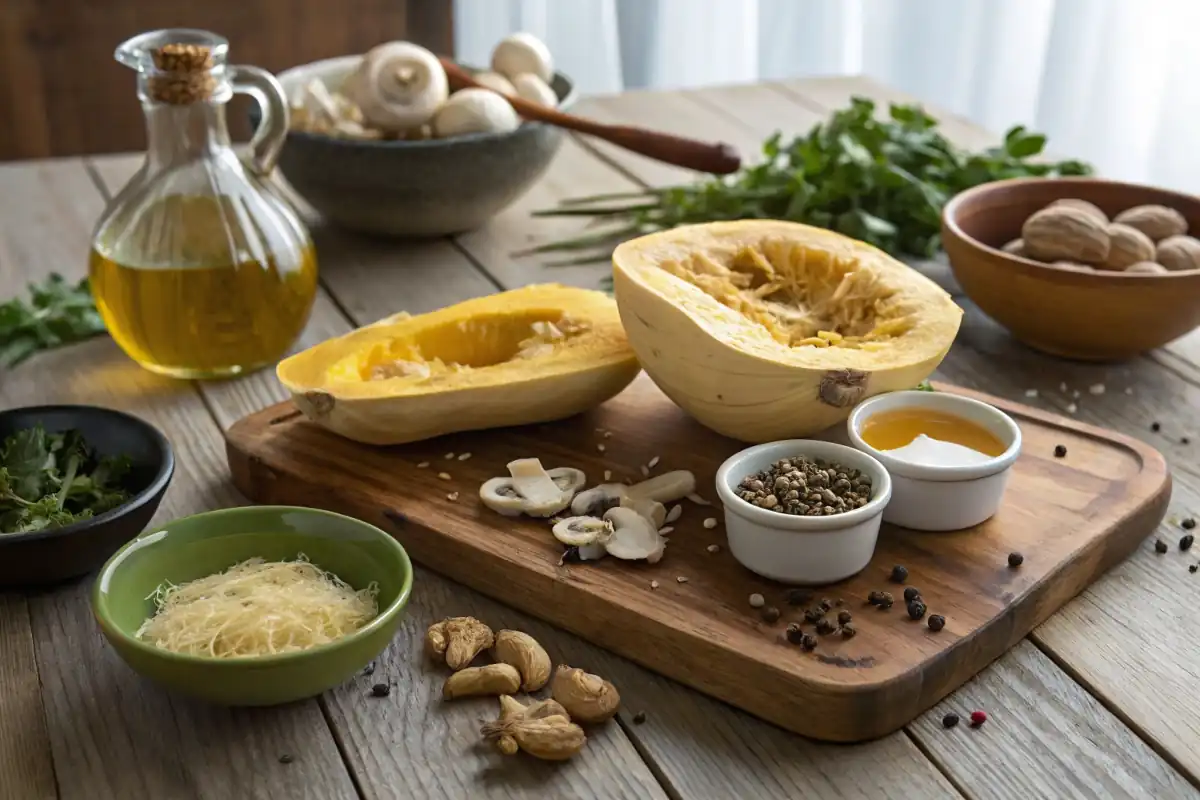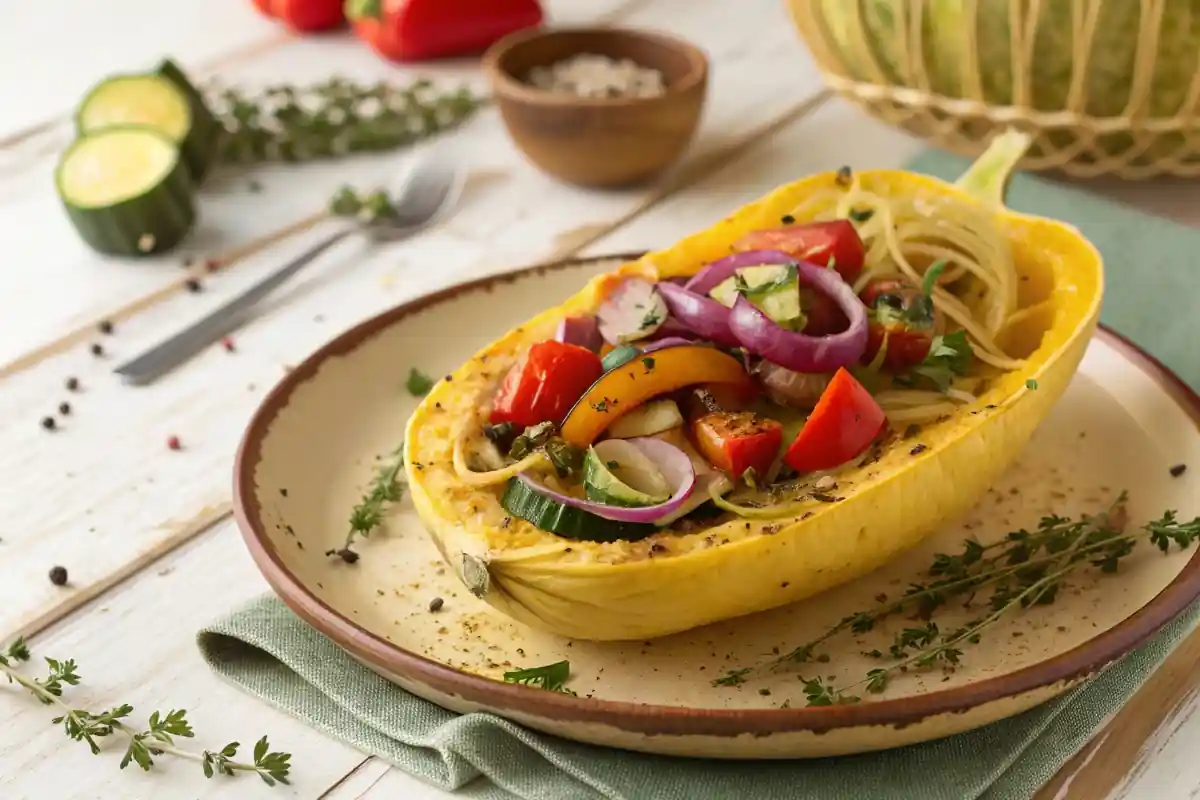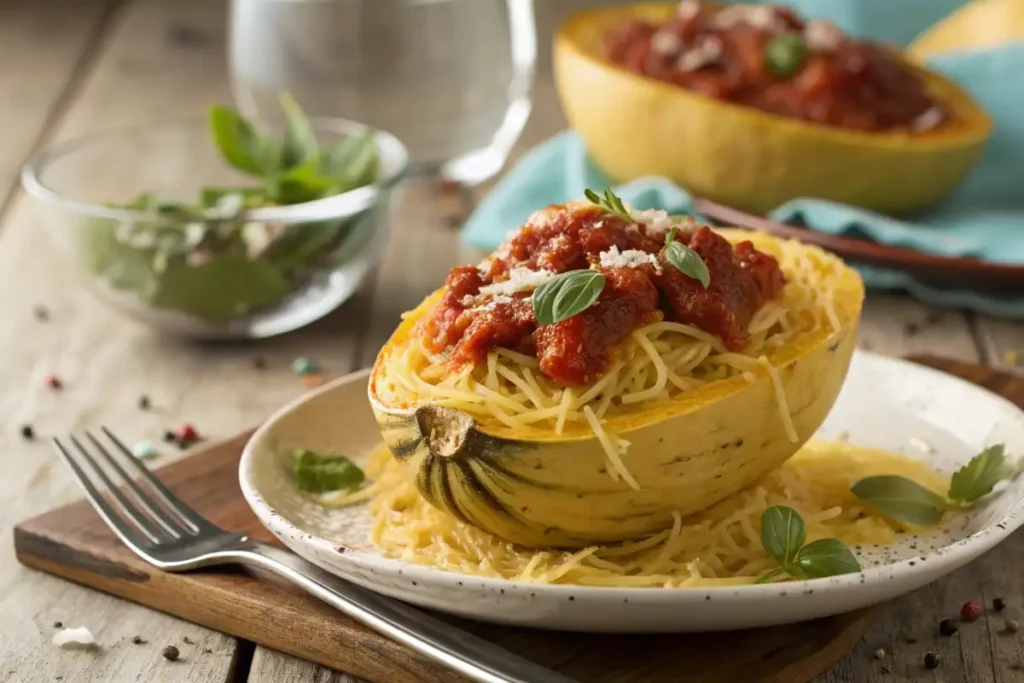Discover how to make delicious vegan squash dishes that are easy and healthy. Learn simple cooking methods and tasty topping ideas.
The Amazing Vegan Spaghetti Squash
Squash is a wonderful and versatile vegetable. It is great for those looking for healthy meal options. The inside of this squash turns into spaghetti-like strands when cooked. It is a naturally low-carb option. This makes it a fantastic alternative to regular pasta. It is also naturally gluten-free and suitable for vegan diets.
Why Choose Spaghetti Squash?
There are several reasons why people love squash. First, it is very easy to prepare. You can bake it, microwave it, or even cook it in a slow cooker. Second, it is very healthy. It is nutrient-dense and low in calories. Lastly, it is flexible. It takes on flavors easily. Thus, it works well with many sauces and toppings. It’s a blank canvas.
How to Prepare Your Vegan Spaghetti Squash
Preparing squash is simple. First, wash the squash thoroughly. Next, cut it in half lengthwise. Scoop out the seeds. You can use a spoon or your hands. Then, choose your preferred cooking method. Baking creates a slightly sweeter taste. Microwaving is quick and easy. Regardless, always remember to season it properly. This is essential for great flavor.
Detailed Recipe: Creamy Vegan Spaghetti Squash with Mushrooms
This recipe is rich, indulgent, and full of flavor. It features a luscious cashew-based cream sauce. It’s combined with earthy mushrooms and tender squash. This creates a wonderfully satisfying meal.

Ingredients:
- 1 medium spaghetti squash
- 1 tablespoon olive oil, plus more for drizzling
- 8 ounces mushrooms, sliced (such as cremini, shiitake, or a mix)
- 2 cloves garlic, minced
- 1/2 teaspoon dried thyme
- 1/4 teaspoon salt, or to taste
- 1/4 teaspoon black pepper, or to taste
- 1 cup raw cashews, soaked in hot water for at least 30 minutes
- 1 cup water
- 1/4 cup nutritional yeast
- 1 tablespoon lemon juice
- 2 tablespoons chopped fresh parsley, for garnish (optional)
Equipment
- Baking sheet
- Large bowl
- Small bowl
- High-speed blender
- Large skillet

Step-by-Step Instructions:
- Get the Squash Ready: Heat your oven to 400°F (200°C). Wash the spaghetti squash thoroughly. Carefully cut it in half lengthwise. Use a spoon to scoop out the seeds and stringy bits from the center of each half.
- Bake the Squash: Place the squash halves cut-side up on a baking sheet. Coat the interior with olive oil and sprinkle with salt and pepper. Bake for 40-50 minutes, or until the flesh is tender. It should pierce easily with a fork. Let it cool slightly before handling.
- Sauté the Mushrooms: While the squash is baking, prepare the mushrooms. Warm 1 tablespoon of olive oil in a large pan over medium heat. Add the sliced mushrooms and cook. Stir occasionally until they are browned and softened. This should take about 5-7 minutes.
- Add Garlic and Seasoning: Add the minced garlic, dried thyme, salt, and pepper to the skillet. Cook for another minute, stirring constantly. This will ensure the garlic becomes fragrant.
- Prepare the Cashew Cream: Drain the soaked cashews. Place them in a high-speed blender. Add 1 cup of water, nutritional yeast, and lemon juice. Blend until the mixture becomes fully smooth and creamy.
- Combine Ingredients: Once the squash is cool enough to handle, use a fork to scrape out the flesh. Create spaghetti-like strands. Add these strands to the skillet with the cooked mushrooms.
- Add the Cashew Cream Sauce: Pour the creamy cashew sauce over the spaghetti squash and mushrooms in the skillet. Gently stir to coat all the strands evenly with the sauce. Cook for a few minutes on low. This will allow the flavors to combine nicely.
- Serve: Serve the creamy vegan squash immediately. Garnish with chopped fresh parsley if desired. You can also add a sprinkle of extra nutritional yeast for an additional cheesy flavor.
Health Benefits of Spaghetti Squash
Squash is not only tasty. It also has great health benefits. It’s a nutrient-rich vegetable. It is perfect for those conscious about what they eat. It is also a great choice for anyone trying to cut down on carbohydrates.
Nutrients and Vitamins
Squash is a good source of vitamins and minerals. It contains vitamin C, vitamin B6, and potassium. It also has some antioxidant compounds. These nutrients are important for overall health. They help support the immune system. They also help keep your body functioning well.
Low in Calories and Carbs
This squash is relatively low in calories and carbohydrates. This makes it a great choice for those limiting carbohydrates. This is good for maintaining a healthy weight. It can also help with blood sugar control. The low glycemic load is great for diabetics. It releases energy slowly. Thus, it keeps blood sugar levels stable.
Fiber Content
Squash is a good source of fiber. Fiber is essential for good digestion. It helps keep your digestive system moving smoothly. It also helps you to feel full and satisfied. This can help with weight management. Fiber is an important part of a balanced diet.
Suitable for Various Diets
This squash fits many diet plans. It is naturally gluten-free. This is great for those with gluten intolerance. It is also vegan. It is a perfect vegetable to eat on a plant-based diet. Its flexibility makes it easy to include in many meals. Thus, it helps meet different dietary requirements.
Tips for Buying and Storing Spaghetti Squash
When buying squash, look for ones that are firm and heavy for their size. The skin should be smooth. Avoid squash with soft spots or bruises. It is best to buy your squash when it is in season. This is typically during the fall and early winter.
How to Store Spaghetti Squash
Store uncut squash in a cool, dark, and dry place. It can last for several weeks this way. Once cut, store leftover squash in an airtight container in the refrigerator. It will stay fresh for about 3 to 4 days. Use it in recipes or eat it as leftovers.
Using Pre-Cooked Spaghetti Squash
You can also buy pre-cooked squash. This makes meal prep faster. Look for options that do not have additives or preservatives. Always check the packaging carefully. Consider how you might use it to reduce prep time.
Simple Ways to Enhance Your Vegan Spaghetti Squash
There are many easy ways to enhance the flavor of squash. Try different herbs and seasoning. A little drizzling of olive oil can also bring a rich flavor. You can also add some toasted nuts for additional texture and flavor.
Seasoning Suggestions
Experiment with different seasoning. Garlic powder, onion powder, and paprika are great. You can use Italian herbs or chili flakes. Try different varieties to find your favorite flavors. Proper seasoning really brings out the best in any dish.
Adding Texture and Crunch
Consider adding some toasted breadcrumbs or nuts. They add an exciting texture to your meal. Sprinkling sunflower seeds or pumpkin seeds can add a nutty flavor. A little bit of crunch can make the meal more interesting. It keeps things enjoyable.
Using Fresh Herbs
Freshness is always key for a great flavor. Adding fresh herbs like basil, parsley, or cilantro can make a big difference. Always add them right before serving. The freshness will shine through in each bite. They make your squash more appealing.
The Appeal of Vegan Spaghetti Squash
Squash is a wonderful meal choice. It offers so much to conscious consumers. Its health benefits are amazing. It is also incredibly flexible. You can adapt it to your tastes. It is a great way to enjoy a delicious meal that is good for you.
A Great Meal Option
It is a wonderful alternative to regular pasta. This is great for those limiting carbohydrates. It is also low in calories. This can support your exercising and weight goals. The ease of preparation makes it a great option for busy people.
Versatile and Customizable
It is very flexible. You can customize it with your favorite flavors. Its versatility means it can fit a range of preferences. You can create an exciting menu that will please everyone. Exploring various pairings can lead to your new favorite dish.
A Healthy Choice
Its nutrient content, including vitamins, fiber, and antioxidants, provides various health benefits. Incorporating it into your diet helps in maintaining a healthy lifestyle. It is a satisfying and nutritious choice.
Exploring Different Cooking Methods in Detail
Beyond baking and microwaving, there are other methods to cook squash. These methods can offer slightly different textures and flavors. Understanding these options allows you to choose what best suits your cooking style. Let’s delve into slow cooking and steaming.
Slow Cooking Your Spaghetti Squash
Slow cooking, or using a crockpot, is a very easy way to prepare squash. Place the whole squash in the slow cooker with about an inch of water. Cook on low for 4 to 6 hours. The squash is ready when it is soft. It is easy to pierce with a fork. The benefit is that it requires minimal effort. This method also results in very tender strands.
Steaming Your Spaghetti Squash
Steaming is another healthy cooking option. Cut the squash in half and remove the seeds. Place the squash halves cut-side up in a steamer basket. Steam for about 20 to 30 minutes. Or until the flesh is tender. This method helps to retain more of the nutrients. It also keeps the squash strands moist and not too soft.
Vegan Cheese Alternatives for Spaghetti Squash
Many people enjoy cheese on their squash. But, for a vegan option, you can use plant-based cheese. There are many great alternatives available today. These can easily compliment your dish. Let’s look at a few.
Nutritional Yeast
Nutritional yeast is a popular vegan option. It has a cheesy flavor. Sprinkle it on top of your squash. This provides a rich, savory flavor. It also adds some extra vitamins and minerals. It is a very simple and delicious option.
Cashew-Based Cheese Sauces
Cashew-based cheese sauces are also a fantastic alternative. You can blend soaked cashews with water, lemon juice, and spices. This makes a creamy, cheesy sauce. It is an indulgent topping for your squash. It can also be flavored with different herbs and seasoning.
Store-Bought Vegan Cheeses
There are also many store-bought vegan cheese options. These come in various forms, such as shredded, sliced, or melted. Experiment to see what you like. They can be a quick and easy way to add a cheesy element to your meals. These are increasingly convenient for modern consumers.

Creating a Balanced Meal with Vegan Spaghetti Squash
Spaghetti squash, while nutritious, works best as part of a balanced meal. Pairing vegan spaghetti squash with other nutrient-rich foods creates a complete and satisfying plate. You should prioritize a mix of macronutrients. This approach will enhance your overall health when enjoying vegan spaghetti squash.
Adding Protein to Your Meal
Protein is essential for muscle growth and repair. If you are a vegetarian or a vegan, you can use beans, lentils, or tofu. You can also use tempeh or edamame. These proteins can add some texture to your vegan spaghetti squash. It will also make the meal more filling, offering a great plant-based protein source.
Including Healthy Fats
Healthy fats are also very important for a balanced diet. You can use avocado, nuts, or seeds. Drizzling olive oil on your vegan spaghetti squash is a good choice. Fats help in the absorption of vitamins. They also help in keeping you satisfied for longer, making your vegan squash meal more complete.
Don’t Forget Your Greens
Adding some leafy greens to your vegan spaghetti squash is essential. Spinach, kale, or collard greens are great choices. They are loaded with nutrients. They also add color and freshness. They also provide additional fiber. This helps promote good digestion when enjoying vegan spaghetti squash.
Vegan Spaghetti Squash for Special Occasions
Spaghetti squash is not just for weeknight dinners. It can also be a sophisticated dish for special occasions. With the right pairings, vegan spaghetti squash can be a memorable part of any celebration. Let’s look at some creative ways to serve it.
Impressing Guests with Elegant Presentation
Serving vegan spaghetti squash in a unique way can make a difference. You could use the squash shell as a bowl. Fill it with vegan sauces and toppings. This elevates the presentation. It also makes the dish more appealing to your guests. A garnish of fresh herbs is always a great addition to your vegan squash.
Creating Sophisticated Pairings
Pair vegan spaghetti squash with sophisticated flavors. Try roasted garlic and truffle oil. Use a vegan white wine sauce. Or try a vegan mushroom ragu. These pairings can make your meal feel more special. They highlight the versatility of vegan spaghetti squash.
Vegan Spaghetti Squash for Holiday Feasts
This squash is a wonderful addition to any holiday meal. It’s a flexible choice for a vegan side dish. Use it as a plant-based stuffing in bell peppers. It could also be part of a larger vegetable medley. This vegan squash is sure to please everyone at the table.
The Environmental Benefits of Choosing Vegan Spaghetti Squash
Choosing spaghetti squash is also an environmentally conscious choice. It is a sustainable option because it requires fewer resources to grow. Choosing plant-based foods in general is good for the planet. Let’s explore why vegan spaghetti squash is a sustainable option.
Low Environmental Impact
Growing squash has a lower environmental impact. Compared to meat production, vegetables use less water. They also produce fewer greenhouse gasses. Choosing plant-based foods, such as vegan spaghetti squash, supports sustainable agricultural practices.
Reducing Food Waste
Using the whole squash, including the seeds, can reduce food waste. Roasting the seeds is a delicious and nutritious way to use every part of the vegetable. Conscious use of the whole product reduces waste. It makes your ingredient choices more sustainable when using vegan spaghetti squash.
Supporting Local Farmers
Choosing local spaghetti squash is great. It reduces your carbon footprint from transportation. It also helps support local farmers. Buying seasonal produce is also better for the environment. It helps reduce the need for packaging when you select a vegan spaghetti squash.
Final Thoughts on Vegan Spaghetti Squash
Spaghetti squash is truly a versatile, healthy, and delicious choice. It is great for weeknight meals. It also works well for more sophisticated occasions. It is a wonderfully flexible vegetable. You can always find a way to fit vegan spaghetti squash into your meal plan. It allows you to express your culinary creativity.
Embracing Plant-Based Eating
Choosing vegan spaghetti squash is a simple way to add more plant-based vegetables to your diet. It shows how delicious, easy, and healthy plant-based eating can be, and is a great vegan option.
Encouraging Culinary Exploration
Do not be afraid to explore different flavors. Try new recipes. Have fun in the kitchen with this flexible vegetable. This is a journey where you create new favorites using vegan spaghetti squash. Therefore, start cooking today!
A Timeless Choice
Spaghetti squash is not a passing trend. It is a healthy and delicious choice. Vegan spaghetti squash can be a timeless part of your eating habits. It’s a wonderful way to maintain a balanced diet.
Frequently Asked Questions (FAQs):
What is the best way to eat spaghetti squash?
The best way to eat squash depends on your preferences. You can bake, microwave, or slow cook it. Then, add your favorite sauces and toppings. Simple options are olive oil and garlic. You can also try vegan pesto or tomato sauce. Roasted vegetables are another good choice.
Is spaghetti squash good or bad for you?
Squash is a very good choice for you. It is low in calories and carbohydrates. It is also rich in nutrients. It has fiber which helps with digestion. It also has several vitamins and antioxidants. Thus, it can contribute to a healthy and balanced diet. It’s very nutritious.
Which squash is like spaghetti?
Squash is the most well known variety that resembles spaghetti. It has a unique flesh that turns into spaghetti-like strands when cooked. No other vegetable is quite like it. It’s a great pasta substitute.
Are spaghetti squash in season?
Squash is typically in season during the fall and early winter. This is when they are freshest and most readily available. Seasonal produce usually tastes best. Also, it is more budget-friendly.

